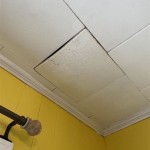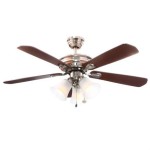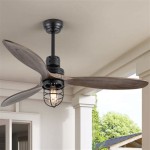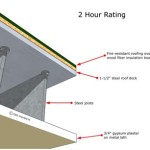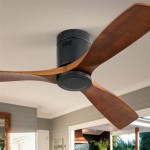What Sizes Do Ceiling Fans Come In?
Ceiling fans are an excellent option for adding style and function to any room. They come in a wide variety of sizes to accommodate any space, from small bedrooms to large living rooms. The size of a ceiling fan is measured by the diameter of the blades, which can range from 24 inches to 72 inches.
The size of the ceiling fan you choose will depend on the size of the room and the desired airflow. For small rooms, a ceiling fan with a blade diameter of 24 to 36 inches will suffice. For medium-sized rooms, a fan with a blade diameter of 42 to 52 inches is recommended. And for large rooms, a fan with a blade diameter of 56 to 72 inches is ideal.
In addition to the size of the blades, the number of blades on a ceiling fan can also affect the airflow. Fans with more blades will typically produce more airflow than fans with fewer blades. However, fans with more blades can also be more expensive and may not be as visually appealing as fans with fewer blades.
When choosing a ceiling fan, it is also important to consider the height of the ceiling. For ceilings that are 8 feet or lower, a ceiling fan with a low-profile design is recommended. Fans with a low-profile design are less likely to interfere with headroom and are less likely to be knocked by tall people.
For ceilings that are 9 feet or higher, a ceiling fan with a standard design is a good option. Fans with a standard design are typically more powerful than fans with a low-profile design and can provide more airflow. However, fans with a standard design can also be more intrusive and may not be as aesthetically pleasing as fans with a low-profile design.
Once you have considered the size of the room, the desired airflow, the height of the ceiling, and the desired style, you can choose the perfect ceiling fan for your home.
Additional Considerations
In addition to the size and style of the ceiling fan, there are a few other factors to consider when choosing a ceiling fan:
- Airflow: The airflow of a ceiling fan is measured in cubic feet per minute (CFM). The higher the CFM, the more airflow the fan will produce.
- Energy efficiency: The energy efficiency of a ceiling fan is measured by the Energy Star rating. Fans with a higher Energy Star rating are more energy-efficient than fans with a lower Energy Star rating.
- Noise level: The noise level of a ceiling fan is measured in decibels (dB). The lower the dB, the quieter the fan will be.
- Control type: Ceiling fans can be controlled by a variety of methods, including wall switches, pull chains, and remote controls.
- Warranty: The warranty of a ceiling fan covers the fan for a certain period of time. The length of the warranty can vary from one manufacturer to another.
By considering all of these factors, you can choose the perfect ceiling fan for your home.

Ceiling Fan Size Guide Delmarfans Com

How To Choose The Right Ceiling Fan Size Advanced Systems

How To Calculate Ceiling Fan Size For Your Room Or Home Core Learning Tech Electronic Tutorials S Q A And More

How To Choose A Ceiling Fan Size Style Hunter

How To Size A Ceiling Fan 7 Steps With S Wikihow

How To Measure A Ceiling Fan Hunter

Ceiling Fans Sizing Guide How To Select The Perfect Size Fan For Your Space

How To Measure For A Ceiling Fan The Home

How To Size A Ceiling Fan 7 Steps With S Wikihow

What Size Ceiling Fan Is Best For Your Room


